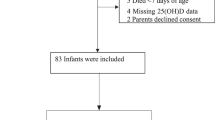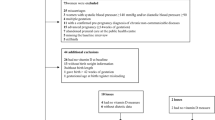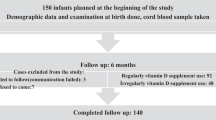Abstract
Objective:
To evaluate the effect of vitamin D levels on early-onset sepsis (EOS) in term infants.
Study Design:
Fifty term infants with clinical and laboratory findings of EOS (study group) and 50 healthy infants with no signs of clinical/laboratory infection (control group) were enrolled. Blood was drawn at the time of admission during the first 3 postnatal days of life in both groups for measurement of 25-hydroxyvitamin D (25-OHD) levels.
Result:
Maternal and neonatal 25-OHD levels (22.2/8.6 ng ml−1, respectively) in the study group were significantly lower than those of the control group (36.2/19 ng ml−1, respectively, P<0.001). A positive correlation was detected between maternal and neonatal 25-OHD levels. Severe vitamin D deficiency was significantly more common in the sepsis group.
Conclusion:
Lower maternal and neonatal 25-OHD levels are associated with EOS. These data suggest that adequate vitamin D supplementation during pregnancy may be helpful to prevent EOS in term neonates.
This is a preview of subscription content, access via your institution
Access options
Subscribe to this journal
Receive 12 print issues and online access
$259.00 per year
only $21.58 per issue
Buy this article
- Purchase on Springer Link
- Instant access to full article PDF
Prices may be subject to local taxes which are calculated during checkout

Similar content being viewed by others
References
Sankar JM, Agarwal R, Deorari AK, Paul VK . Sepsis in the newborn. Indian J Pediatr 2008; 75: 261–266.
Ng PC, Lam HS . Diagnostic markers for neonatal sepsis. Curr Opin Pediatr 2006; 18: 125–131.
Lawn JE, Cousens S, Zupan J . For the Lancet Neonatal Survival Steering Team. Neonatal survival 4 million neonatal deaths: When? Where? Why? Lancet 2005; 365: 891–900.
Black RE, Cousens S, Johnson HL, Lawn JE, Rudan I, Bassani DG et al. Global, regional, and national causes of child mortality in 2008: a systematic analysis. Lancet 2010; 375: 1969–1987.
Stoll BJ, Hansen NI, Sánchez PJ, Faix RG, Poindexter BB, Van Meurs KP et al. Early onset neonatal sepsis: the burden of group B streptococcal and E. coli disease continues. Pediatrics 2011; 127: 817–826.
Schuchat A, Zywicki SS, Dinsmoor MJ, Mercer B, Romaguera J, O'Sullivan MJ et al. Risk factors and opportunities for prevention of early-onset neonatal sepsis: a multicenter case-control study. Pediatrics 2000; 105: 21–26.
De Luca HF . Overview of general physiologic features and functions of vitamin D. Am J Clin Nutr 2004; 80: S1689–S1696.
Clancy N, Onwuneme C, Carroll A, McCarthy R, McKenna MJ, Murphy N et al. Vitamin D and neonatal immune function. J Matern Fetal Neonatal Med 2013; 26: 639–646.
Kempker JA, Han JE, Tangpricha V, Ziegler TR, Martin GS . Vitamin D and sepsis: an emerging relationship. Dermatoendocrinol 2012; 4: 101–108.
Muhe L, Lulseged S, Mason KE, Simoes EA . Case control study of the role of nutritional rickets in the risk of developing pneumonia in Ethiopian children. Lancet 1997; 349: 1801–1804.
Najada AS, Habashneh MS, Khader M . The frequency of nutritional rickets among hospitalized infants and its relation to respiratory diseases. J Trop Pediatr 2004; 50: 364–368.
Wayse V, Yousafzai A, Mogale K, Filteau S . Association of subclinical vitamin D deficiency with severe acute lower respiratory infection in Indian children under 5 y. Eur J Clin Nutr 2004; 58: 563–567.
Karatekin G, Kaya A, Salihoglu O, Balci H, Nuhoglu A . Association of subclinical vitamin D deficiency in newborns with acute lower respiratory infection and their mothers. Eur J Clin Nutr 2009; 63: 473–477.
Belderbos ME, Houben ML, Wilbrink B, Lentjes E, Bloemen EM, Kimpen JL et al. Cord blood vitamin D deficiency is associated with respiratory syncthial virus bronchiolitis. Pediatrics 2011; 127: e1513.
Gitto E, Karbownik M, Reiter RJ, Tan DX, Cuzzocrea S, Chiurazzi P et al. Effects of melatonin treatment in septic newborns. Pediatr Res 2001; 50: 756–760.
Mulligan ML, Felton SK, Riek AE, Bernal-Mizrachi C . Implications of vitamin D deficiency in pregnancy and lactation. Am J Obstet Gynecol 2010; 202: 429e1–429ee.
Manroe BL, Weinberg AG, Rosenfeld CR, Browne R . The neonatal blood count in health and disease. Reference values for neutrophilic cells. J Pediatr 1979; 95: 89–98.
Rodwell RL, Leslie AL, Tudehope DI . Early diagnosis of neonatal sepsis using a hematological scoring system. J Pediatr 1988; 112: 761–767.
Mukhopadhyay S, Puopolo KM . Risk assessment in neonatal early sepsis. Semin Perinat 2012; 36: 408–415.
Gniadecki R, Gajkowska B, Hansen M . 1,25-Dihydroxyvitamin D3 stimulates the assembly of adherens junctions in keratinocytes: involvement of protein kinase C. Endocrinology 1997; 138: 2241–2248.
Schauber J, Dorschner Ra, Coda Ab, Büchau As, Liu Pt, Kiken D et al. injury enhances tlr2 function and antimicrobial peptide expression through a vitamin D dependent mechanism. J Clin Invest 2007; 117: 803–811.
Liu PT, Stenger S, Li H, Wenzel L, Tan BH, Krutzik SR et al. Toll-like receptor triggering of a vitamin D-mediated human antimicrobial response. Science 2006; 311: 1770–1773.
Sadeghi K, Wessner B, Laggner U, Ploder M, Tamandl D, Friedl J et al. Vitamin D3 downregulates monocyte TLR expression and triggers hyporesponsiveness to pathogen-associated molecular patterns. Eur J Immunol 2006; 36: 361–370.
Levy R, Malech HL . Effect of 1,25-dihydroxyvitamin D3, lipopolysaccharide, or lipoteichoic acid on the expression of NADPH oxidase components in cultured human monocytes. J Immunol 1991; 147: 3066–3071.
Youssef DA, Miller CW, El-Abbassi AM, Cutchins DC, Cutchins C, Grant WB et al. Antimicrobial implications of vitamin D. Dermatoendocrinol 2011; 3: 220–3229.
Camargo CA Jr, Ingham T, Wickens K, Thadhani R, Silvers KM, Epton MJ et al. Cord-blood 25-hydroxyvitamin D levels and risk of respiratory infection, wheezing, and asthma. Pediatrics 2011; 127: 180–187.
Moller S, Laigaard F, Olgaard K, Hemmingsen C . Effect of 1,25-dihydroxy-vitamin D3 in experimental sepsis. Int J Med Sci 2007; 4: 190–195.
Madden K, Feldman HA, Smith EM, Gordon CM, Keisling SM, Sullivan RM et al. Vitamin D deficiency in critically ill children. Pediatrics 2012; 130: 421–428.
McNally JD, Menon K, Chakraborty P, Fisher L, Williams KA, Al-Dirbashi OY et al. The association of vitamin D status with pediatric critical illness. Pediatrics 2012; 130: 429–436.
Braun A, Chang D, Mahadevappa K, Gibbons FK, Liu Y, Giovannucci E et al. Association of low serum 25-hydroxyvitamin D levels and mortality in the critically ill. Crit Care Med 2011; 39: 671–677.
Grant WB . Vitamin D supplementation of mother and infant could reduce risk of sepsis in premature infants. Early Hum Dev 2010; 86: 133.
Grant WB . Vitamin D supplementation could reduce risk of sepsis in infants. World J Pediatr 2010; 6: 185.
Marshall I, Mehta R, Petrova A . Vitamin D in the maternal-fetal-neonatal interface: clinical implications and requirements for supplementation. J Matern Fetal Neonatal Med 2013; 26: 633–638.
Hatun S, Ozkan B, Bereket A . Vitamin D deficiency and prevention: Turkish experience. Acta Paediar 2011; 100: 1195–1199.
Pehlivan I, Hatun S, Aydogan M, Babaoglu K, Gokalp AS . Maternal vitamin D deficiency and vitamin D supplementation in healthy infants. Turk J Pediatr 2003; 45: 315–320.
Institute of Medicine (US) Committee to Review Dietary Reference Intakes for Vitamin D and Calcium. Ross AC, Taylor CL, Yaktine AL, Del Valle HB (eds). Dietary reference intakes for vitamin D and calcium. National Academies Press: Washington DC, 2011.
Holick MF, Binkley NC, Bischoff-Ferrari HA, Gordon CM, Hanley DA, Heaney RP et al. Evaluation, treatment and prevention of vitamin D deficiency: an Endocrine Society clinical practive guideline. J Clin Endocrin Metabol 2011; 96: 1911–1930.
Hollis BW, Wagner CL . Vitamin D and pregnancy: skeletal effects, nonskeletal effects, and birth outcomes. Calcif Tissue Int 2013; 92: 128–139.
Hollis BW, Johnson D, Hulsey TC, Ebeling M, Wagner CL . Vitamin D supplementation during pregnancy: double blind, randomized clinical trial of safety and effectiveness. J Bone Min Res 2011; 26: 2341–2357.
Wagner CL, McNeil R, Hamilton SA, Winkler J, Rodriguez CC, Warner G et al. A randomized trial of vitamin D supplementation in 2 community health center networks in South Caroline. Am J Obstet Gynecol 2013; 208 (137): e1–13.
Hollis BW, Wagner CL . Vitamin D requirements and supplementation during pregnancy. Curr Opin Endocrinol Diabetes Obes 2011; 18: 371–375.
Wagner CL, McNeil RB, Johnson DD, Hulsey TC, Ebeling M, Robinson C et al. Health characteristics and outcomes of two randomized vitamin D supplementation trials during pregnancy: a combined analysis. J Steroid Biochem Mol Biol 2013; 136: 313–320.
Schroth RJ, Lavelle C, Tate R, Bruce S, Billings RJ, Moffatt ME . Prenatal vitamin D and dental caries in infants. Pediatrics 2014; 133: e1277–e1284.
Author information
Authors and Affiliations
Corresponding author
Ethics declarations
Competing interests
The authors declare no conflict of interest.
Rights and permissions
About this article
Cite this article
Cetinkaya, M., Cekmez, F., Buyukkale, G. et al. Lower vitamin D levels are associated with increased risk of early-onset neonatal sepsis in term infants. J Perinatol 35, 39–45 (2015). https://doi.org/10.1038/jp.2014.146
Received:
Revised:
Accepted:
Published:
Issue Date:
DOI: https://doi.org/10.1038/jp.2014.146
This article is cited by
-
The role of vitamin D receptor gene polymorphism in the development of necrotizing enterocolitis
Pediatric Research (2023)
-
Determinants of vitamin D status in Kenyan calves
Scientific Reports (2020)
-
Is Lower Vitamin D Level Associated with Increased Risk of Neonatal Sepsis? A Prospective Cohort Study
The Indian Journal of Pediatrics (2020)
-
Investigation of association between maternal 25-OH vitamin D serum levels and neonatal early onset sepsis in newborns by evaluating key factors
Lipids in Health and Disease (2019)
-
Vitamin D deficiency and clinical outcomes related to septic shock in children with critical illness: a systematic review
European Journal of Clinical Nutrition (2019)



